Menu
Alpha Brain-Wave Neurofeedback: Social and Economic Impact on Community
Home » Alpha Brain-Wave Neurofeedback: Social and Economic Impact on Community
Alpha Brain-Wave Neurofeedback: Social and Economic Impact on Community
James V. Hardt, PhD
Alice Miller
In a recent paper,1, we described a pilot study done on a cohort of 63 Canadian male and female aboriginals using neurofeedback training. The neurofeedback training consisted of a set of methods and technologies to provide individuals with immediate information about what their brains are doing while their brains are working. It is like a mirror of brain activity, and it informs the trainee in real-time. Feedback, derived from an EEG signal on naturally occurring frequencies in the brain, is provided as a core component of this therapy. Most individuals are unaware of the subtle ongoing fluctuations and variations in brain activity. By learning to increase one’s alpha brain waves voluntarily, one can reduce anxiety. This was first reported by Hardt (Conflicting results in EEG alpha feedback studies: why amplitude integration should replace percent time. Hardt JV, Kamiya J.Biofeedback Self Regul. 1976 Mar;1(1):63-75) and then by Hardt & Kamiya (Anxiety change through electroencephalographic alpha feedback seen only in high anxiety subjects. Hardt JV, Kamiya J. Science. 1978 Jul 7;201(4350):79-81). This latter study showed that anxiety was inversely related to the amount of EEG alpha activity of the brain. Neurofeedback is now increasingly recognized as an effective treatment for both clinical and non-clinical populations.We set out to do a short-term study to understand the need for a larger and longer-term study. A 2-5 year study will provide 2 years of additional training to gather sufficient data and 3 additional years of follow-up on the trainees.Because questions about economics and social engagement before the training were not collected, it was determined for this short-term study to look retrospectively for the required data. The best method to employ would be to administer a retrospective questionnaire to the trainees and their circle of contacts, including their family, friends, and co-workers. The goal here is to show trends and indicators which could be further established in a larger study. To support the responses that were to be provided by the trainees, their family, friends, and co-workers would be asked similar questions.The 117 trainees were sent a request to consult with their friends, family, and coworkers to answer a survey about them regarding their alpha brain wave training.Dr. Hardt and his team sourced scientists from various disciplines to assist in the design of the study and contemplate being a member of the team to design and develop a longer 5-year study. The science team includes Economists, Anthropologists, Ethnologists, Sociologists, Psychologists, Statisticians, and a Program Evaluator. The scientists were sourced in Canada and Mexico.The scientists were briefed on the questions that the questionnaire needed to address and was asked to develop the questions that they thought would allow them to answer them. With their collective input, the formulation of the questions was divided into three surveys: (1) Trainee, (2) Family and Friends, and (3) Coworkers.The team of scientists was asked to review the surveys and provide feedback on their perceived ability to answer if the training had a social and economic impact on the wider community. They were asked to rate their level of confidence in respect to the survey questions:
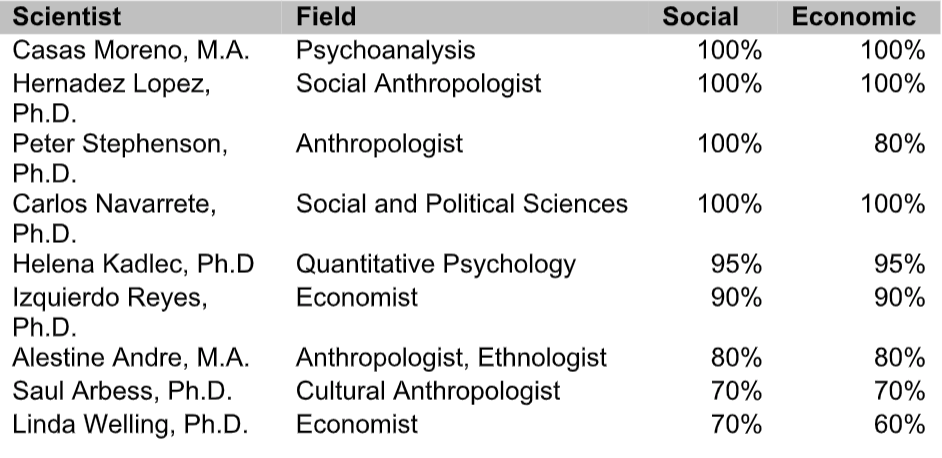
Survey Respondents
The survey was sent out to the Trainees, Friends and Family, and Coworkers through the online tool Survey Monkey. They were given one week to respond initially, and then a 5 day extension period was added. The respondents were paid $25 to complete the survey, and they had an opportunity to win one of two iPad 2 tablet devices. The Trainees were in one drawing, and the members of their circle were in another drawing.

Some of the trainees could not be reached because their contact information was no longer active or valid email addresses were not available. Some trainees asked not to be contacted since they did not have time to be involved.
Collected Data
The information contained in the surveys included quantitative and qualitative data. The qualitative data was formatted to allow the reviewer to see the trainee and their family, friends, and coworkers’ responses together as they relate to the trainee. The open format answers by the Trainee are contained in the Qualitative Survey Comments section of this report.
The quantitative data was extracted, and Dr. Helena Kadlec and Alice Miller did statistical analysis on the data. Using the SPSS statistics tool, the Multivariate analysis was run by topic following the survey layout as the questions were logically grouped by category. Also, the Univariate analysis was done for each of the questions on the four surveys. Two of the questions from the trainee survey, which were specific to the financial activities of the trainees, were presented in formats that required Chi-Squared, Sign, and Binomial tests (Questions 23 and 24).
One of the scientists, Dr. Saul Arbess, reviewed the surveys and identified the specific questions to the social and economic impact. Dr. Arbess’s review is contained within the Results section. Dr. Kadlec formatted the statistical analysis for these questions and has provided the graphical representation showing the responses for the four groups on each of the questions. She also reviewed the data and interpreted the data on two key questions from the trainee survey, questions 23 and 24, that addressed the economic impact specifically. Both the data analysis and Dr. Kadlec’s analysis are contained within the Results section.
The scientists were asked to review the data with an open invitation to request any additional data or formats that they would require. The scientists were asked to assess the data on a volunteer basis. The feedback from the scientific team confirmed that the data collected was useful to them for their ability to address if there were social and economic impacts of the training.
Scientists’ Feedback
The scientists were asked to review the output from the study, which included the raw data, formatted qualitative data, and the statistical analysis, to provide comments on the data about the question of social and economic impact on the greater community. The comments that were available at this time are presented below.
Given the data analysis I have seen from Dr. Kadlec, I believe that there is scope for a larger, longer study. The current retrospective data suggests some positive changes in financial activity and life direction (changing jobs, continuing education) that can potentially benefit long-term economic benefits. Also, there are indications of increases in self-confidence and more positive interactions with others, both socially and at work. At the very least, the individuals who have already undergone the training should be followed for a longer time frame to see if and how these potential benefits continue. Some additional financing for the next 2-5 years would be required to undertake this follow-up. Also, it seems that there are enough positive indicators in the existing data to suggest that a longer-term, larger study would be a worthwhile undertaking. Further analysis of the existing data and a larger data set is needed to see whether one, two, or three training sessions per subject would be more beneficial. It seems that the time and money expense of each session are relatively inexpensive, given the potential benefits.
Dr. Linda Welling, Associate Professor of Economics, University o f Victoria
Increased security of individuals, feeling good about oneself, work skills, and improved perceptions of our work and productivity are the basis for the entrepreneurial development of a society. The first evidence of results with the Retrospective Survey shows an improvement in the Trainee and the community’s perception of them (Friends, Family and Co-workers) in some aspects such as labor and personality traits. A Trainee’s professional and personal life seems to be better for a person who did receive Alpha training compared to before their training.
Dr. Alain Reyes Izquiedo, Economist and MS Public Policy
Results show that particularly about key life changes – changing jobs and starting/expanding their own business – the Alpha Training changed the lives of a large majority (over 70%) of the Trainees. This is not trivial. The results of this retrospective survey related to the trainees’ personality, emotional and social aspects, which we found to be also impacted by the Alpha Training, suggest that the Alpha Training impacts the trainees’ overall level of confidence and ability to actively take their own lives into their hands and make positive changes. And while the causal relationships between these factors cannot be inferred from this study (because this is an observational study with one group), the survey findings strongly encourage further, more rigorous research that would establish a more direct causal link between the effects of Alpha Training and trainees’ positive life-changing behaviors.
Dr. Helena Kadlec, Quantitative and Experimental Psychologist, Senior Scientist in private industry
All economic activity is preeminently a form of exchange. Participation in economic activity is deeply rooted in networks and affiliations. To the degree that trainees feel a better sense of connection to those around them and openness to trying new things, economic results will be potentiated. To measure these directly will take a longitudinal study, but we can expect positive economic outcomes where their potential is not thwarted. Economic activity is not, at the individual level, motivated by personal gain; it is far more fundamentally related to the ideas of fulfillment, contribution, assisting others with funds, engaging in travel, learning, leisure, and sporting activities, as well as possibly increased consumption levels of many things, including better quality food. These are all based on social connectedness, which the training appears to enhance greatly.
Peter H. Stephenson, Ph.D., Director, School of Environmental Studies& Professor of Anthropology, University of Victoria
From both the quantitative and qualitative responses of both the trainees in the Alpha program and the observations of coworkers, friends, and family, the results clearly indicate a frequently dramatic change in feeling, motivation, and behavior, having a positive effect on the community through improved interpersonal relations. Amongst all the various healing programs available to aboriginal people in Canada, this is one of the most successful. One of its strong advantages is the relatively brief period for healing and transformation to occur in as little as seven intensive days of treatment in the Alpha One training. However, changes are consolidated and increased with Alpha Two and Alpha Three trainings. Regarding the economic benefits, many of the comments suggest only an increase in efficiency, creativity, and productivity, but the trend is strongly in that direction.
Dr. Saul Arbess, Cultural Anthropology
Notes the World Health Organization that mental health is defined as a welfare state in which the individual realizes his or her own abilities, can cope with normal stresses of life, can work productively and fruitfully, and contribute to their community. The human being is a bio-psycho-social, so any change in any of these issues impacts others. Accordingly, the survey results submitted concerning trainees of the Alpha Training confirmed that the effect of this training had presented psychological processes that have favored the strengthening of various capacities.
Eduard Casas, Psychoanalysis
Overall the survey questionnaires completed by trainees indicate that the Biocybernaut training has had a positive and immediate impact on the majority who attended the alpha training sessions. The positive impacts are evident after the first session and are carried through to the third session and beyond despite the lapse between sessions. The term ‘engaged indifference’ was the most common phenomenon that trainees experienced in their personal lives and social settings. People have picked themselves up and started moving forward with the lives. Generally, the impacts rippled outward from the trainee and around to their co-workers, friends, and family members.
Alestine Andre, Cultural Anthropologist
Results
Statistical Analysis
The statistical analysis demonstrated that the changes that were reported were statistically significant. The analysis of the questions that Dr. Arbess identified to demonstrate social and economic impact is presented below in tables and charts. Dr. Kadlec has organized the data by category, with the Trainees, Family, Friends, and Co-workers grouped where they measure the same aspects.
The charts show the means concerning each of the four categories of respondents. The weighting scale of the questions ranged from -5 (Less) to +5 (More), with 0 indicating No Change.
Personality Traits

Univariate Analyses
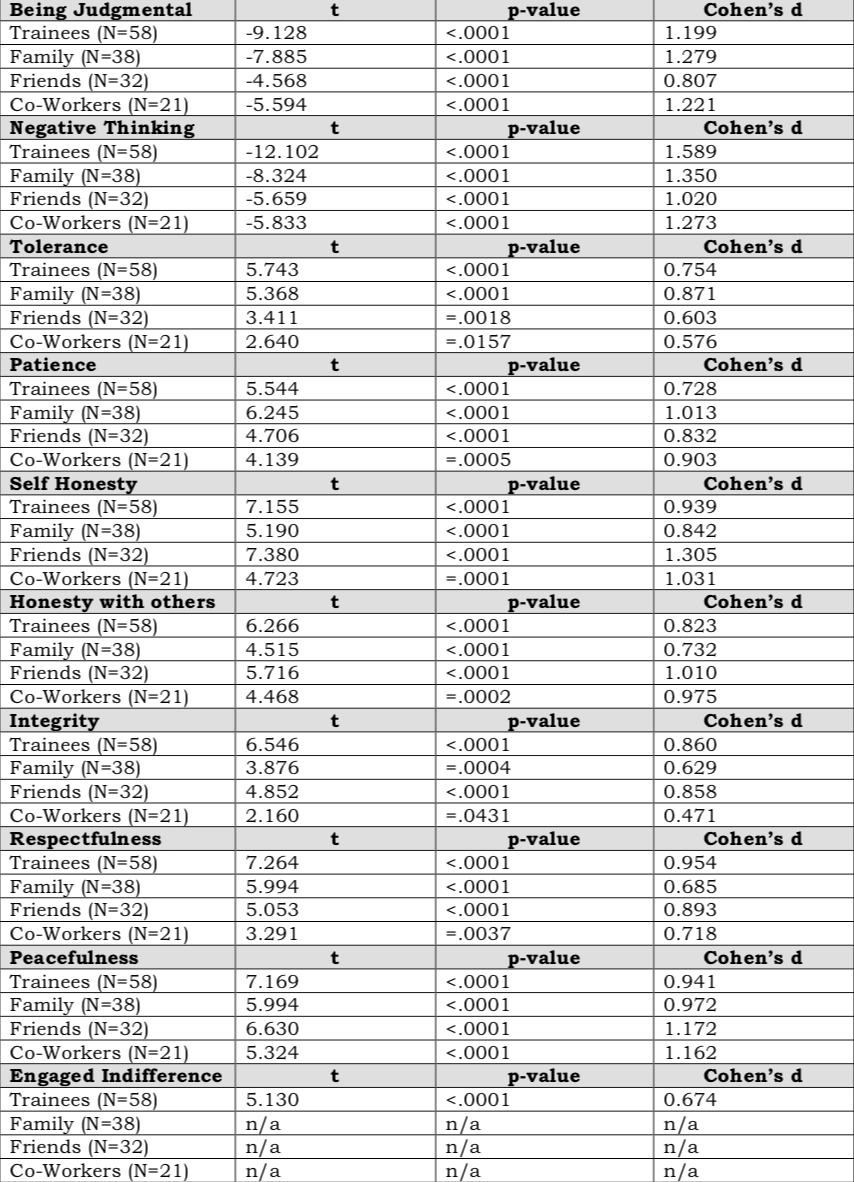
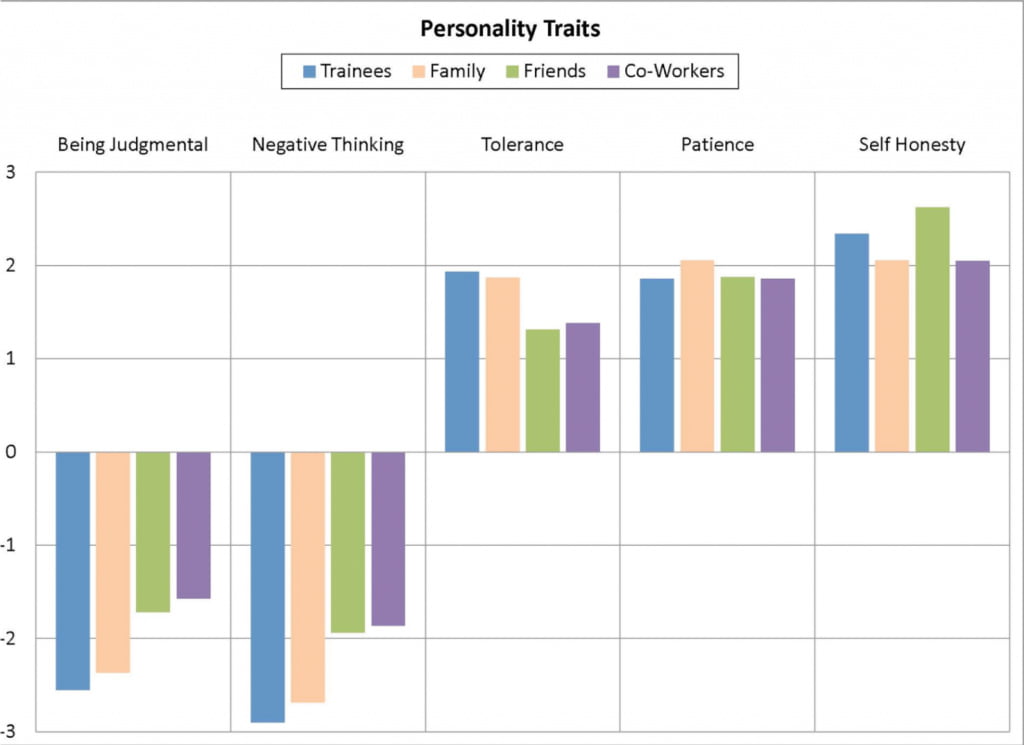


Communication Abilities

Univariate Analyses
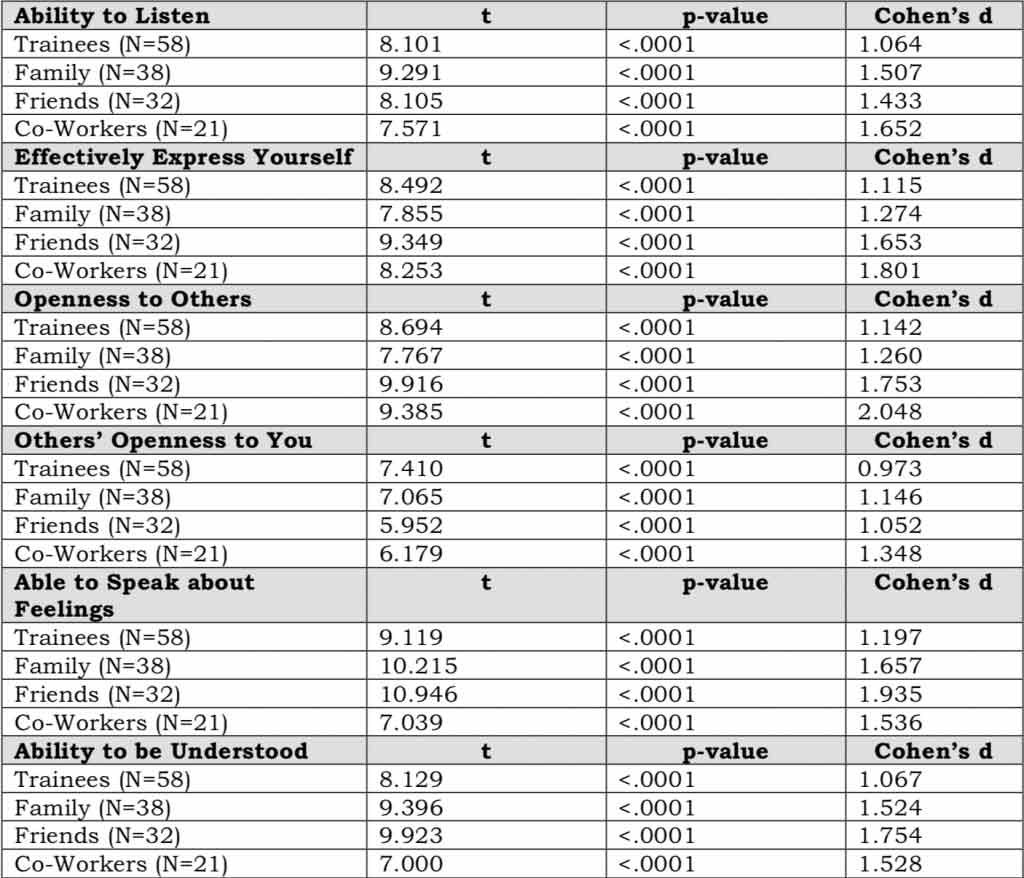

Personal Interactions

Univariate Analyses
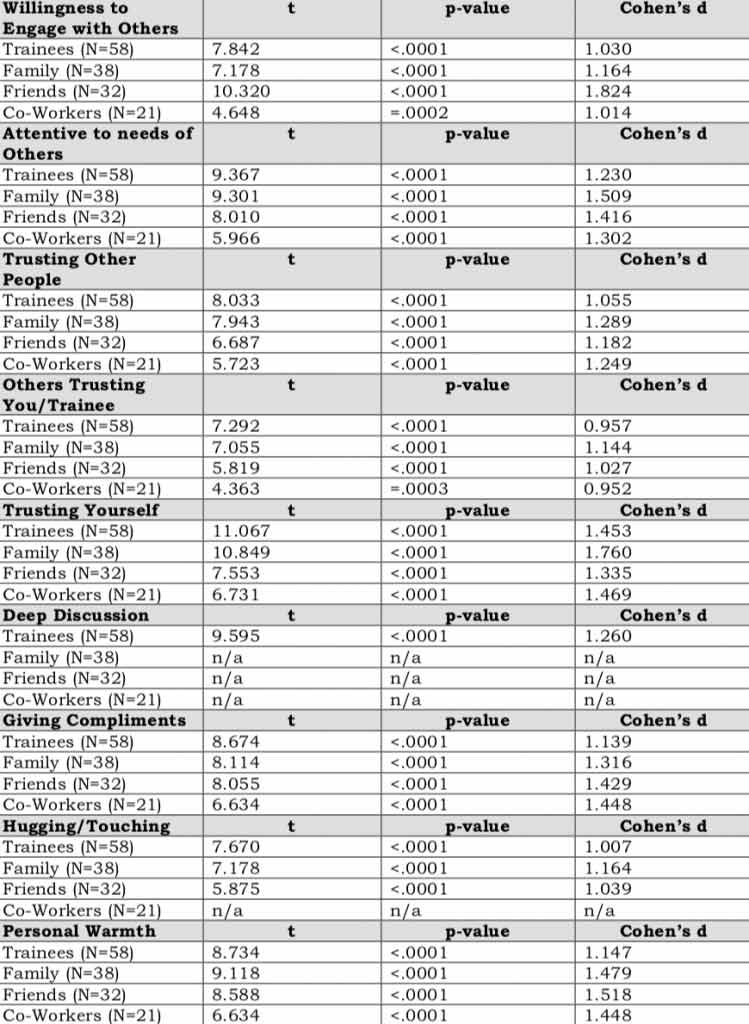

Positive Emotional Expressions

Univariate Analyses

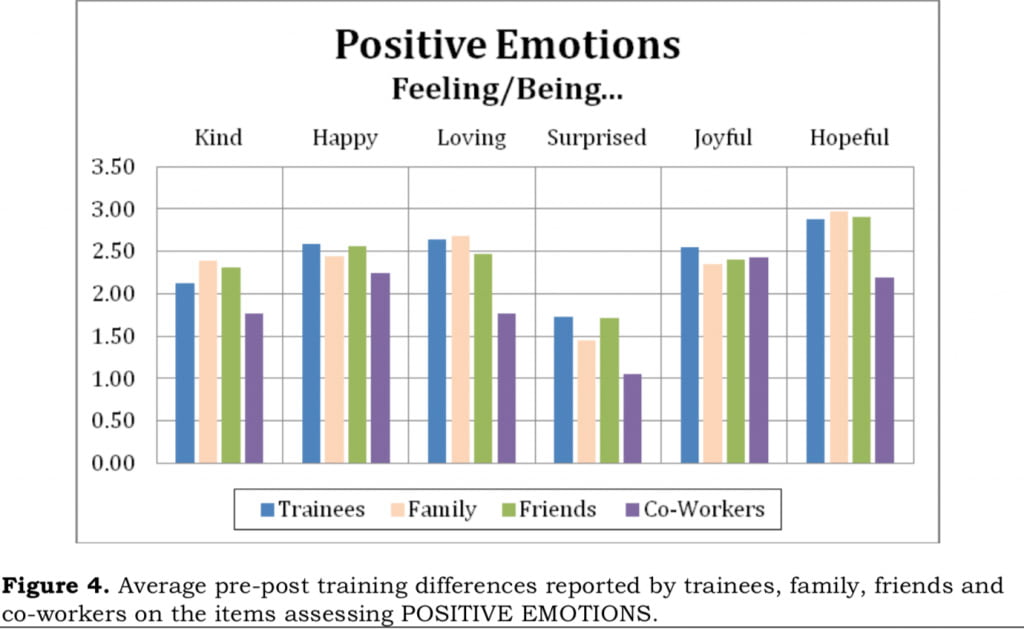
Negative Emotional Expressions

Univariate Analyses
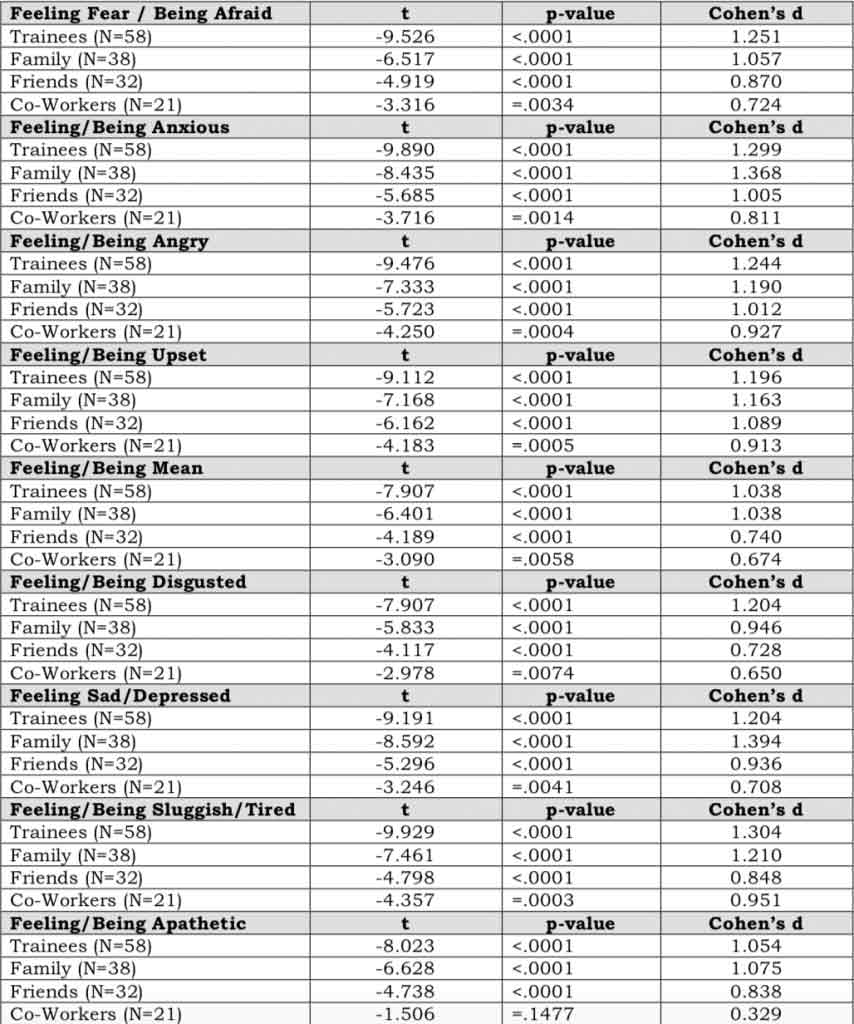

Positive Attitudes and Behavior Changes

Univariate Analyses
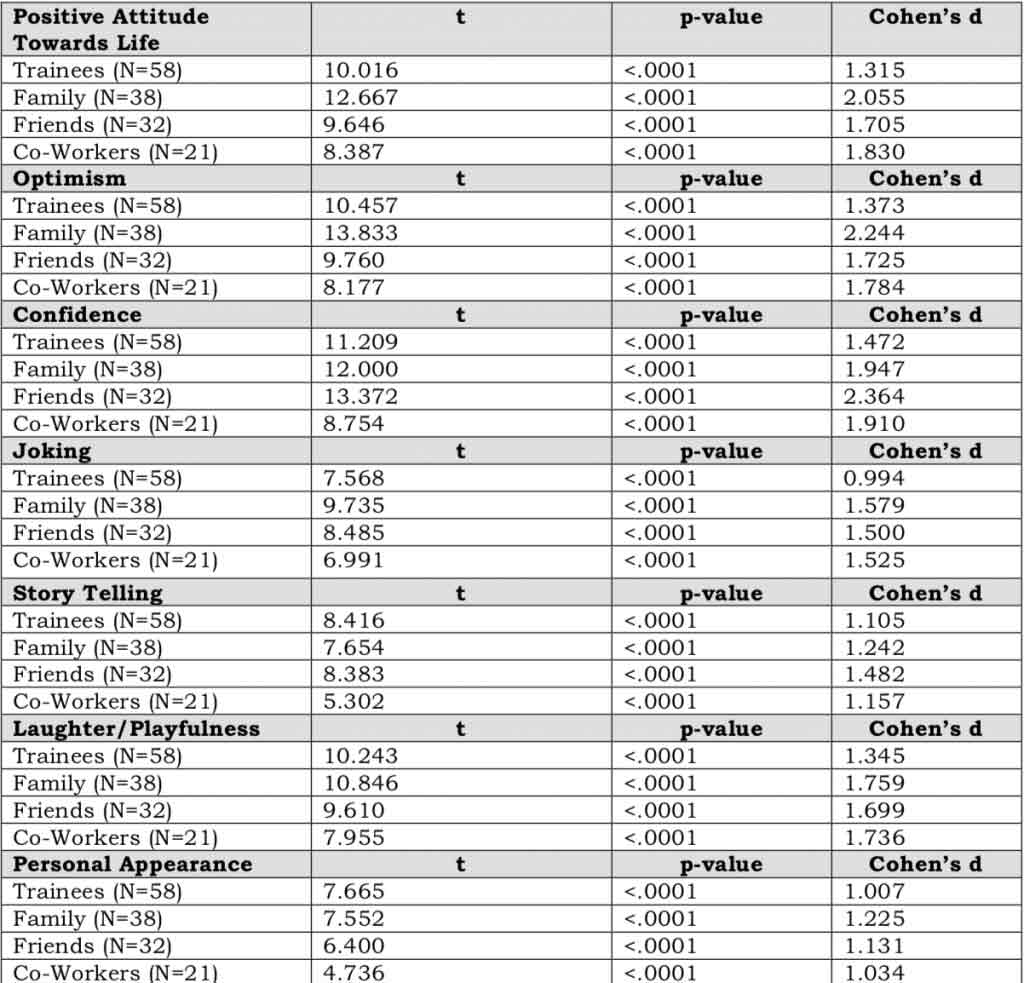

Negative Attitudes and Behavior Changes

Univariate Analyses
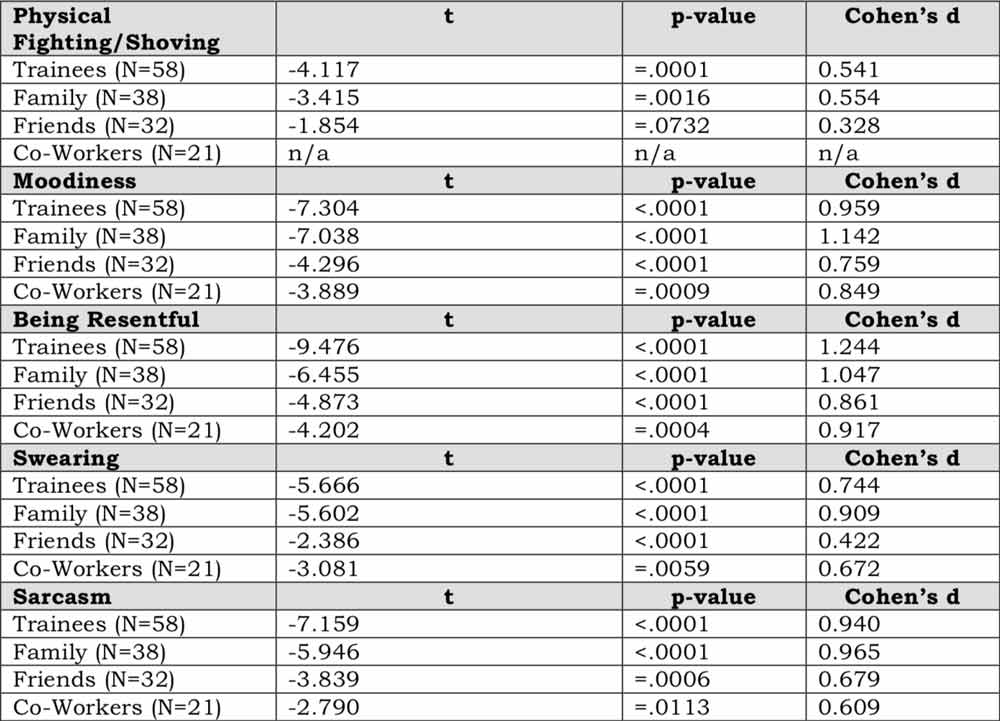


Family Roles

Univariate Analyses

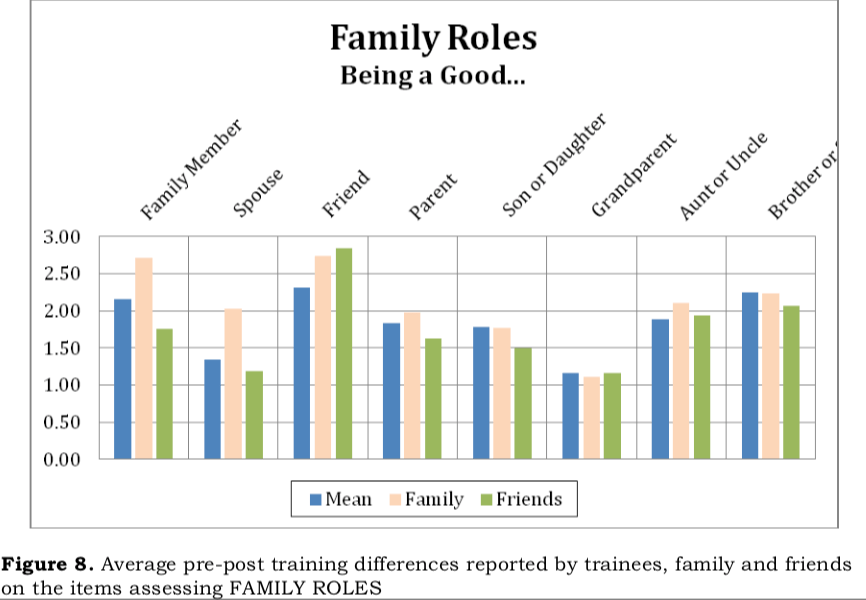
Cultural and Spiritual Development

Univariate Analyses


Work Environment

Univariate Analyses


Income, Savings and Financial Behaviour (Dr. Helena Kadlec)
Five items were asked about the trainees’ Income and Savings. The trainees were asked to indicate whether they experienced any changes when they compared their situation before their Alpha Training to their situation after Alpha Training. The distributions of the 58 survey respondents across the three response options – decrease, no change, or increase – are summarized in Figure 11 below. Analyses to test whether the findings are statistically significant are discussed below, and all show that significantly significant changes did occur. Whereas on each item, the majority (50.0% to 65.5%) of the trainee respondents indicated no change, more of those who reported a difference due to the Alpha Training, the difference was in the positive direction. Specifically, higher proportions of trainees reported an increase in their income (29.3%), source of income (34.5%), saving amounts (37.9%) and value of investments (31.0%), and a significantly high percentage of trainees who reported a decrease in their debt levels (43.1%).
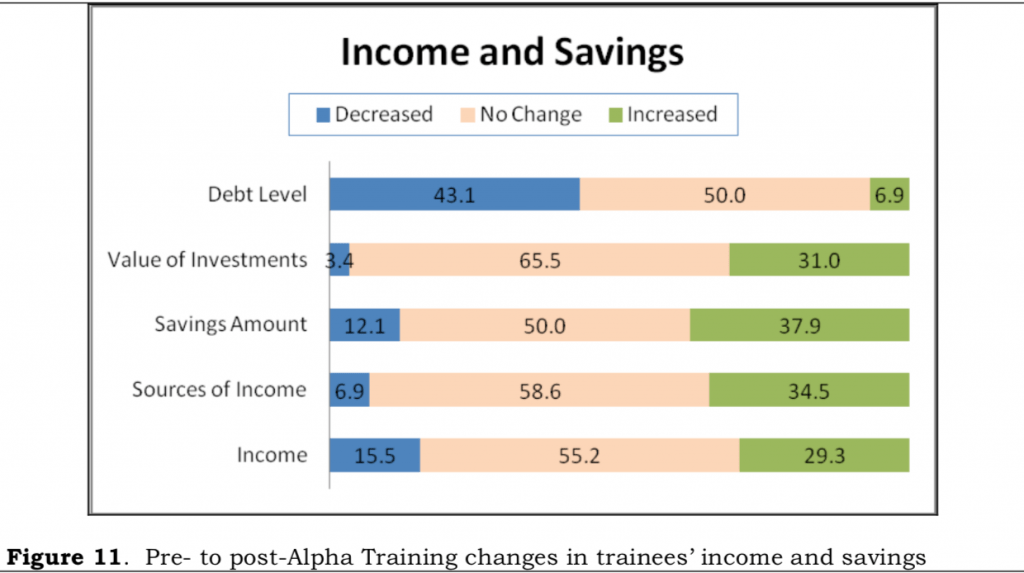
To assess the differences in the proportions of respondents across the three response options, two types of analyses were conducted: Chi-square Goodness-of-Fit tests for the proportions of respondents across the three response categories; and sign tests to test whether the differences in proportions between ‘increased” versus “decreased” were statistically significant. The Chi-square (χ2) Goodness-of-Fit test assesses the observed pattern of proportions against hypothesized proportions representing a null effect (no change). Typically, the “null effect” is one where each category is equally likely; e.g., for a question with three response categories, the expected proportions would be .333. This can also be interpreted as respondents answering each question “randomly.” The results of this test for the present survey results are shown in the top row of Table 1. For each of the five indicators, the null hypothesis is rejected, meaning that the proportions of respondents across the three response categories are not equal.
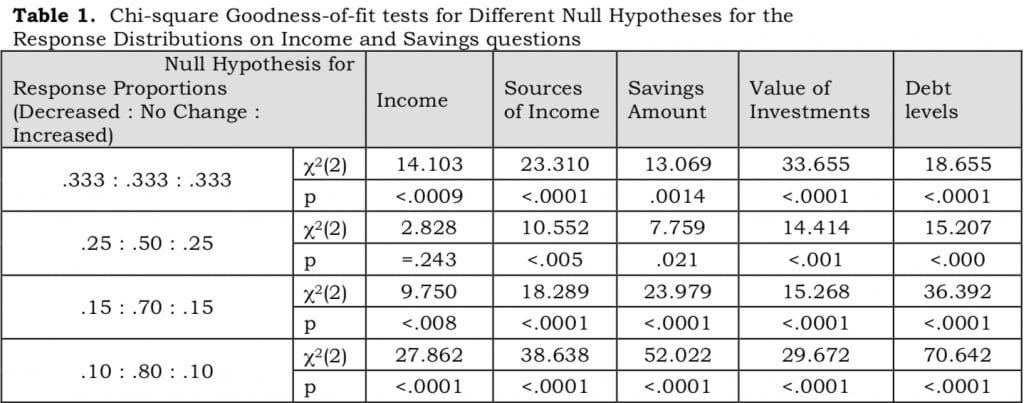
It could, however, be argued that one really should not expect equal proportions across the three categories of responses. If there truly was no effect of Alpha Training perceived by the trainees, all respondents should have chosen the “no change” response category. This would be a null hypothesis with expected response proportions of 0:100:0 across the [decreased: no change: increased] response categories. The Chi-square test, however, cannot deal with zeros (it would require division by zero). We, therefore, tested a series of null hypotheses with “symmetric” distributions on the response categories, with the “no change” category having the majority of respondents and the two “change” categories having fewer but equal proportions of respondents.
The results of these null hypothesis tests are also shown in Table 1. Except for one case, all of these null hypotheses were rejected meaning. This indicates that the changes that were observed were not “symmetric.” In other words, the proportions of respondents who reported an increase in their income/savings situation were statistically different from the proportion of those who indicated a decrease. The one exception to this conclusion was the Income variable, where the .25:.50:25 hypothesis was not rejected (p=.243). This suggests that the proportion of respondents who reported an increase in their income (pre- to post-Alpha Training) was equal to those who reported a decrease (within statistical error), with the two sides effectively balancing each other out.
Another way to look at the difference between the proportions of trainees who increased versus decreased their income and savings is with the sign test. In this test, one sign (say an increase) is considered a “success,” the other sign (decrease) a “failure,” and no change is considered a “tie” (these are effectively “ignored” in conducting the null hypothesis test). Under the null hypothesis, the difference between the number of successes and failures is expected to be zero. If the null hypothesis is rejected, then the number of successes is considered statistically higher than the number of failures. The results of the sign tests for the five income and savings variables are shown in Table 2. These results confirm what the Chi-squared results have also shown us above: no overall effect on Income, but more trainees reporting an increase in their sources of income (20 of 24 trainees), savings amounts (22 or 29 trainees), and value of their investments (18 of 20 trainees) as well as significantly more trainees (25/29) reporting a decrease in their debt levels.

The trainees’ financially-related activities (Financial Behaviour, Q24) were assessed with six items shown in Figure 12. These data show that 72% of the survey respondents changed jobs, and 71% started or expanded their own business. Furthermore, between 10 and 19% of these trainees also returned to school (19%) and bought or are currently buying real estate or property (10%), a major appliance (16%), or a car (19%). While it is difficult to say whether these were direct effects of the Alpha Training per se (we would have to have a control group or a population-based comparison figure, e.g., what percentage of the general population buys a car during the equivalent time period), these results show that particularly about key life changes – changing jobs and starting/expanding their own business – the Alpha Training changed the lives of a large majority (over 70%) of the trainees. This is not trivial. The results of this retrospective survey related to the trainees’ personality, emotional and social aspects, which we found to be also impacted by the Alpha Training, suggest that the Alpha Training impacts the trainees’ overall level of confidence and ability to actively take their own lives into their hands and make positive changes. And while the causal relationships between these factors cannot be inferred from this study (because this is an observational study with one group), the survey findings strongly encourage further, more rigorous research that would establish a more direct causal link between the effects of Alpha Training and trainees’ positive life-changing behaviors.1

These proportions speak for themselves. However, to be thorough, we did conduct some statistical hypothesis tests to provide some objective rationale for our conclusions that the Alpha Training had a positive impact on the trainees’ financial behaviors. As was the case with the income and savings data discussed above, performing these statistical hypothesis tests requires some reasonable estimates for what the “normal”/non-Alpha-Trained population did concerning these behaviors during the same time period. In the absence of having these at our disposal, we performed several hypothesis tests with reasonable guesses.
The appropriate statistical test for a dichotomous variable is a Binomial test (if the sample size is huge, this is well approximated by a z-test). In the first set of tests,
we tested the null hypothesis that surveys participants were responding yes/no “randomly” (i.e., the proportion of “yes” and “no” responses under the null hypothesis would be expected to be 50-50). The Binomial tests for each of the six financial behaviors were rejected with p-values, all less than .0022 (see Table 3). The second set of tests was conducted to test the hypothesis that everyone would respond “no” (i.e., no pre- to post- Alpha Training changes were noted). These results are shown in the right-hand column in Table 3 and show that even the smallest proportion (the 10.3% buying real estate) is significantly more than zero in this sample (p=.0056).
1 A study with an appropriate comparison/control group (perhaps two control groups) would strengthen the causal inference that Alpha Training per se leads to such changes in personality, emotional, social, and financial aspects of people’s lives. Furthermore, with a larger sample, more statistically sophisticated analyses can be performed (e.g., structural equation modeling), which would allow assessing the directions of the causal effects, such as Alpha Training causing personality changes which in turn cause changes in financial behavior, versus a model where personality and financial changes are both non-causal but correlated outcomes of the Alpha Training.
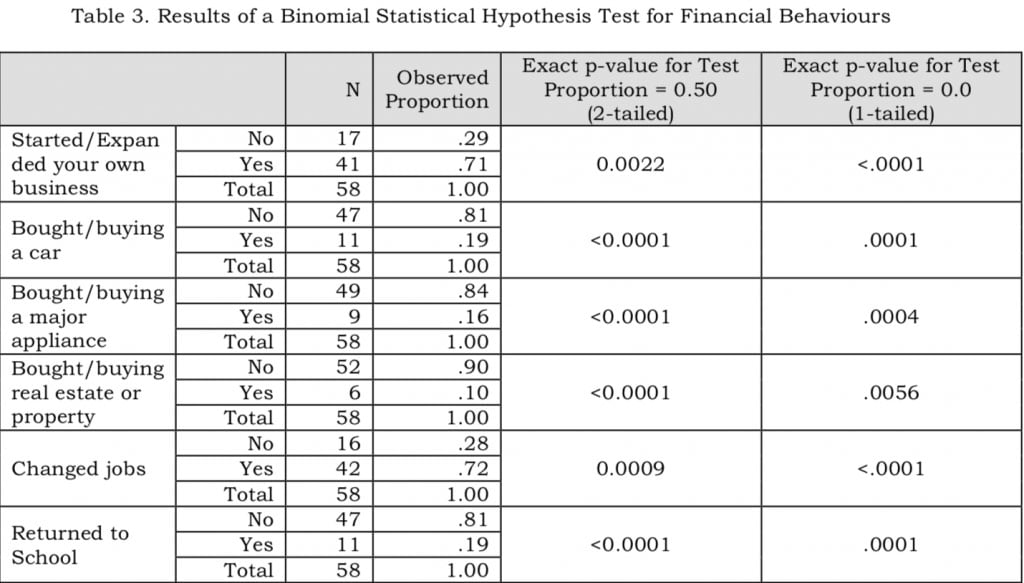
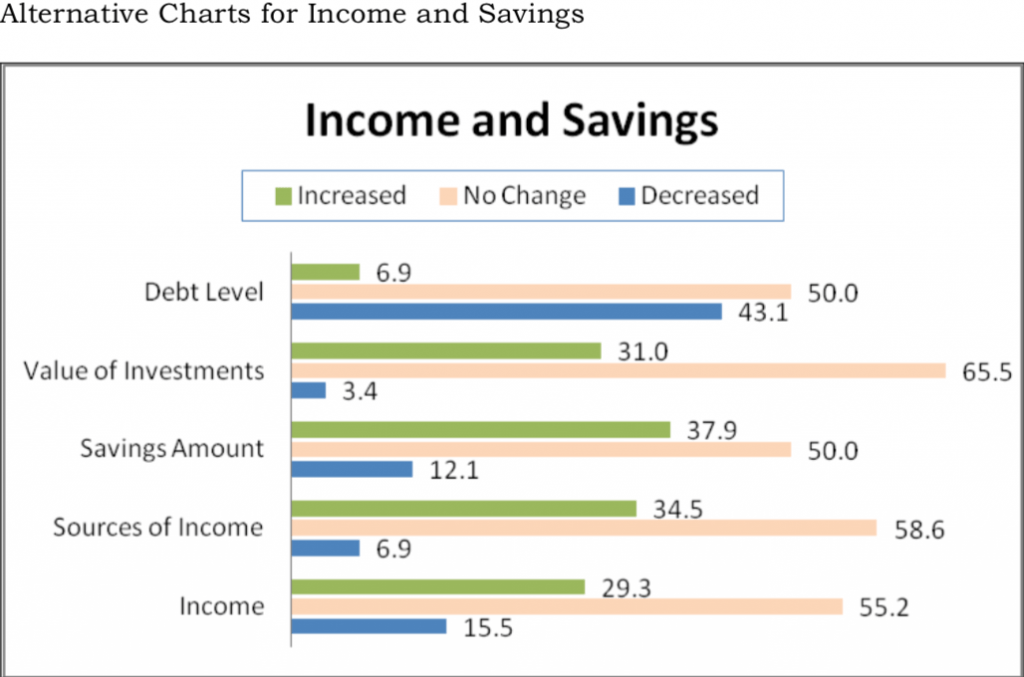
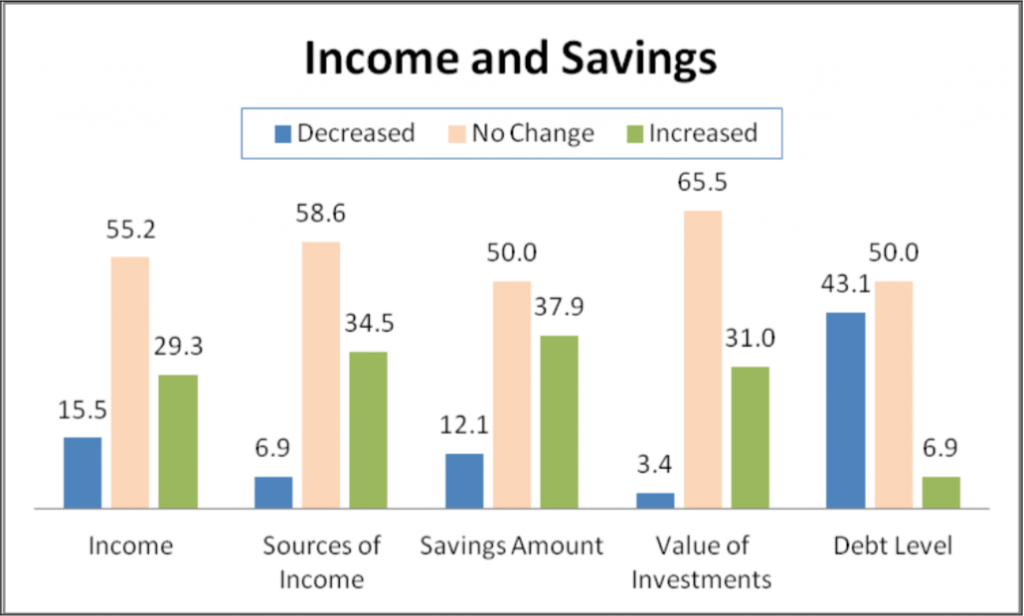
Social and Economic Impact of Training (Dr. Saul Arbess)
I was requested to analyze the data to determine strong correspondences/agreements across respondent categories – trainee, friends/coworkers, and coworkers. Actually, it is not always easy to discriminate between the two questions that come under the concept of social capital when defined as social relations that have productive benefits. In this study, personal development and social relations indicate highly significant before and after shifts that suggest economic productivity gains. Still, they are more difficult to establish, primarily due to the absence of sufficient time between the training and subsequent time in the workplace for these to be revealed. Several of the questions that attempt to measure change here were answered in the “no change” category, primarily for this reason. Nonetheless, the trend is clearly positive, as I will show below.
Social Capital from the Point of View of Relationships Outside of the Workplace
Note: The items are identified first, by the trainee’s question, then by the friend/family and coworker question number, for example, Q2/4. The full grid is appended below as well. Coworkers are excluded from questions Q 10, 13-17.
Areas of strong and significant agreement across respondent categories:
Personality traits of peacefulness, honesty, and a reduction of negative thinking (Q2/4)
Communication abilities of openness to others, self-expression, and the ability to speak about feelings (Q3/5)
Personality interactions of attentiveness to other’s needs, giving compliments, and expressing personal warmth (Q4/6)
General reduction of negative emotional traits (Q7/7) and significant increase of states of being happy, joyful, and hopeful Q8/8)
Attitudes and behavior changes yielding a more positive attitude toward life, optimism, confidence and a sense of playfulness, and increased laughter with a decrease in moodiness and resentfulness (Q11/11). General improvement in family relations across kinship categories (Q17/17)
Increase in spiritual and cultural development
Social Capital from the Point of View of Relationships in the Workplace
Note: The questions below refer only to trainees and coworkers.
Coworkers indicated a positive shift in the trainees’ strengths in the following areas, and these strengths were reflected in the trainees’ personal responses:- Trainees were seen as good colleagues and team players, showing initiative, accepting responsibility, and with an increased problem-solving ability (Q12/13)
Note: Again, it must be stressed that, in several questions in the survey, there was insufficient elapsed time, from the training to the time of the survey, to allow the respondents to adequately discriminate between options, yielding a frequency response of “no change,” in a given item. An anticipated longitudinal study will rectify that situation.
Friends and Family Comments on Changes in the Trainee Following the Training(s)
In this section, I have performed a content analysis of the observations of the friends and family. The most frequently occurring descriptive phrases to describe the changes are:
More self-aware, more open, happier, more optimistic, more relaxed, more tolerant, more confident.
The general sense one gets from the observations made of the trainees that, for the most part, they are much easier to be around, that they have a lightness of being while being more assertive, without being confrontational or expressing anger. They have a greater “zest for life,” are more joyful, open, and loving, with new energy. They are more grounded, have a better understanding of their feelings and emotions, and better express them.
The trainees have also had a positive impact on their friends and families. Some self-observations are:
I can be more tolerant, [she] inspires me to be better and more engaged in life, [I] have learned new things from her, I want to spend more time with…
The general sense one gets from the self-observations of friends and family is of a “ripple effect” that the trainee has, based on the post-training behavior they exhibit. Several comments refer to the significant breakthroughs that have occurred in the trainees towards greater personal authenticity. This produces a desire in others to seek counsel or spend more time with them.
Qualitative Responses from Survey
An important component of the data received in the survey was the comments made by the Trainees and their circle of contacts: Family, Friends, and Co-workers. Dr. Peter Stephenson reported on the comments made by the Trainees and the Co-workers.
Thematic Observations: (Dr. P.H.Stephenson)
- The more training individuals have, the more articulate they become about themselves, and their own ‘self-worth’ statements increase in their intensity.
a) Individuals at Alpha Two or Alpha Three report being better able to assess where they used to be, as well as where they are now. This suggests much deeper changes that have moved (some) people from suicidal ideation to levels of self-esteem that represent self-confidence and an empathic response towards others.
b) This self-evaluation, in turn, is what seems to underlie a large amount of communication around the theme of ‘optimism.’ People who previously had quite a grim view of the universe—not just society—have altered to the point where they feel like they are in a dialectical relationship to the world around them: both influencing it and being influenced by it. Which is to say, THEY FEEL CONNECTED. This sense of connection, rather than disengagement, is very salient and is in turn connected to all of the comments from family and co-workers.
Even for ‘laid-off’ workers, economic elements indicate a wider openness to seeking work in alternative fields.
a) Perhaps this indicates a new self-assessment of one’s abilities and one’s inherent self-worth.
b) Trainees indicate spending less time on solitary and isolating activities (computer games, etc.), which is also about increased connection to others. All economic activity is ultimately about making connections (it is, after all, exchange), and so this is a positive element.
3. Evaluations by co-workers are limited, but irrespective of the client’s background or occupation, the co-worker assessments reflect a nearly constant thematic refrain: increasing calmness, increased ability to focus, and better listening abilities.
a) These are interpreted as well by others as indicating that the trainee has heretofore untapped mentorship abilities. They want to be like them, be around them, and are admired.
4. Nearly all of the trainees focus on the changes they have experienced in their relationships with their families: these are overwhelmingly positive.
One can draw examples from most of these responses to summarize the points made above since they are found throughout.
Discussion
No organ in the human body is as protected as the brain. It is almost surrounded by bone, the skull. The brain is also the most sensitive and least regenerative organ in the body. It receives the most freshly oxygenated blood from the heart via the carotid arteries, the first arteries that branch out from the aorta. People want to have a clear and sharp mind for as long as they live. Yet emotional stress is very common in most societies and contributes to symptoms of anxiety and depression and other negative personality changes. One of the leading causes of medical disability in Canada and the United States continues to be depression and accounts for nearly 10% of all medical disabilities. (The World Health Organization. The global burden of disease: 2004 update, Table A2: Burden of disease in DALYs by cause, sex and income group in WHO regions, estimates for 2004. Geneva, Switzerland: WHO, 2008.) In psychiatry and psychology, treatments consist mostly of prescription medications and psychotherapy. In the United States, antidepressants are now the second most commonly prescribed drugs, according to research published in the Archives of General Psychiatry, and used by 1 in 10 Americans over the age of 12, with an effectiveness that is sometimes no more effective than placebo. (Gueorguieva R; Mallinckrodt C; Krystal J.Trajectories of Depression Severity in Clinical Trials of Duloxetine: Insights Into Antidepressant and Placebo Responses. Arch Gen Psychiatry. 2011;68(12):1227-1237.)
Studies have shown that negative emotions have cumulative pathophysiological consequences and lead to coronary heart disease. As an example, the chronic stimulation of the sympathetic nervous system from persistent emotional stress raises blood pressure and increases heart rate. It also increases the secretion of catecholamines, leading to elevated levels of epinephrine and norepinephrine, and this, in turn, leads to hippocampal stressors. (Kubzansky LD. Sick at heart: the pathophysiology of negative emotions. Cleveland Clin J Med. 2007;74(sl):s67-72.) Chronic unpredictable stress is known to stimulate the release of corticosterone and decreases the neurogenesis of the hippocampus. (Differential Response of Hippocampal Subregions to Stress and Learning. Hawley D, Morch K, Christie B, Leasure J. PlosOne: December 28, 2012). As another example, in a study known as INTERHEART with the participation of 29,972 patients from 52 countries, assessments were made of the impact of nine different conventional risk factors on acute myocardial infarction. Anxiety, anger, depression, and other psychological stressors were a higher risk factor for developing an acute myocardial infarction than hypertension, abdominal obesity,
diabetes, and several other traditional risk factors. (Yusuf S, Hawken S, Ounpuu S, et al. Effect of potentially modifiable risk factors associated with myocardial infarction in 52 countries (the INTERHEART study): a case-control study. Lancet. 2004 Sep 11- 17;364(9438):937-52.) This clearly demonstrates that negative emotions directly affect coronary heart disease by way of the repeated sympathetic nervous system and hypothalamic-pituitary-adrenocortical axis activation, inflammation, and immune dysregulation. Numerous other studies link anxiety and depression to medical disorders and diseases.
The long-term benefit of any treatment is commonly at the forefront of the prognosis of both the health care professional and the treatment recipient. This is an ancient and essential factor of all treatment modalities. In the previous study we published, we showed how alpha brain-wave neurofeedback training significantly decreased anxiety, depression, hypochondriasis, hysteria, masculinity/femininity psychaesthenia, schizophrenia, and social introversion. By aiding these trainees in reducing these
psychopathologies, we are also helping them by reducing the co-morbid conditions discussed above that are associated with them. This study demonstrates the significant social and economic impact of alpha brain-wave neurofeedback in the communities where the trainees live. The combined results of the benefits from alpha brain-wave neurofeedback training in reducing cardiovascular disease and its co-morbidities and the economic and social impact on the communities where the trainees live are very considerable and positive effects. Further long-term studies are needed to measure the outcomes of this study and the previous one.
THIS AREA LEFT OUT DELIBERATELY FOR DR. HARDT TO ADD HIS ADDITIONS TO THE DISCUSSION.
Summary
The research project was conducted over a three-month period to ascertain the effectiveness of alpha brain wave training in making a positive social and a positive economic difference in the community of the trainee.
A retrospective survey was completed of the trainees and their circle of contacts:
family, friends and co-workers. This data provided insight into the financial, physical, emotional and mental health of the trainees and their networks. The trainees’ reports on the improvements in significant areas of their lives, both home and work, were corroborated by their family, friends and co-workers, who reported independently and anonymously. Indeed, some of the trainees’ family, friends and co-workers reported that they made changes in their own behaviour as a result of the changes they observed in the trainee.
In a previous research paper, we were able to demonstrate that there were significant beneficial changes in personality and in the lives of the trainees when they returned home. With this new study on the Social and Economic Impact on Community, Biocybernaut was able to go beyond individual benefits and show how those changes in the trainees’ personalities positively affected their circle of contacts and their home and work lives. The changes in the trainee also appear to beneficially impact the social and economic fabric of the community. Dr. Linda Welling, Associate Professor of Economics, University of Victoria, commented about the effectiveness of the Training on the social and economic impact on the Trainee and their community:
It seems to me that the time and money expense of each session is relatively inexpensive, given the potential benefits.
From the analysis and commentary provided by the scientists through to the direct feedback from the trainees and their circle of contacts, a case has been made that alpha brain wave training has impacted the social and economic fabric of the community.
